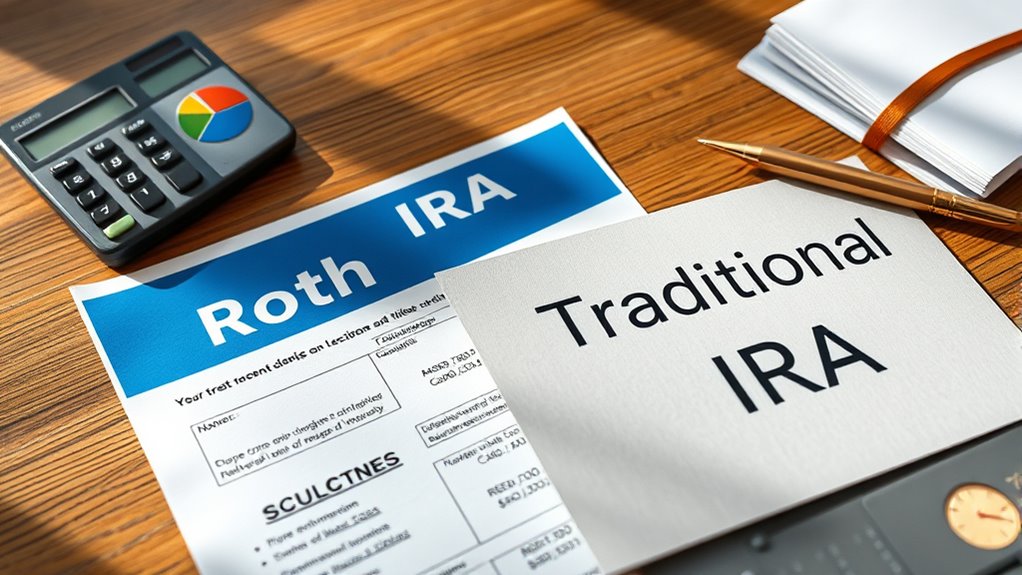When choosing between a Roth and traditional IRA, consider your current tax situation and your expectations for retirement. If you want immediate tax benefits and expect to be in a lower tax bracket later, a traditional IRA could be better. If you prefer tax-free withdrawals and think your taxes will be higher in retirement, a Roth may suit you. Factors like income limits, contribution rules, and future tax rates influence the decision. Keep exploring to understand which option aligns best with your goals.
Key Takeaways
- Consider current versus future tax rates: Roth offers tax-free withdrawals if future rates are higher; Traditional provides immediate tax deduction.
- Evaluate income limits and eligibility: Roth has income thresholds, while Traditional IRAs have no income restrictions but may be non-deductible.
- Assess your retirement timeline and contribution flexibility: Roth allows penalty-free withdrawals of contributions anytime; Traditional has early withdrawal penalties.
- Analyze Required Minimum Distributions (RMDs): Traditional IRAs require RMDs, while Roth IRAs do not during the account holder’s lifetime.
- Match account choice to long-term growth and tax planning goals: Roth maximizes tax-free growth; Traditional offers current-year tax benefits.
Tax Treatment of Contributions

When it comes to the tax treatment of contributions, the main difference between Roth and Traditional IRAs is how they impact your taxes now versus later. With a Traditional IRA, your contributions are often tax-deductible, meaning you can lower your taxable income in the year you contribute. However, you’ll pay taxes when you withdraw the money in retirement. In contrast, Roth IRA contributions are made with after-tax dollars, so you don’t get an immediate tax break. But when you withdraw in retirement, those earnings and contributions are tax-free, provided certain conditions are met. This distinction influences your current tax planning and future income, making it essential to weigh your current versus future tax situation when choosing between the two. Additionally, understanding the tax implications of each account type can help you optimize your retirement savings strategy. Being aware of tax laws can further assist in making an informed decision that aligns with your overall financial goals. For example, changes in tax legislation could alter the benefits associated with each account type over time.
Income Limits and Eligibility

Your eligibility to contribute to a Roth or Traditional IRA depends largely on your income level. For a Roth IRA, there are income limits that restrict high earners from contributing directly. If you’re single and your modified adjusted gross income (MAGI) exceeds $138,000 (for 2023), your contribution begins to phase out, and you’re ineligible above $153,000. For married couples filing jointly, the phase-out range is $218,000 to $228,000. Traditional IRA contributions, however, aren’t limited by income, but your ability to deduct those contributions on your taxes may be affected if you or your spouse participate in a workplace retirement plan and your income exceeds certain thresholds. Always check current limits annually, as they can change. Additionally, understanding digital literacy programs can help seniors navigate and utilize these retirement options more effectively, especially when considering complex rules like tax implications of different IRA types.
Current vs. Future Tax Rates

Understanding your current and future tax rates can substantially influence whether a Roth or Traditional IRA makes the most sense for your retirement savings. If you expect to be in a higher tax bracket later, a Roth IRA might be advantageous because you’ll pay taxes now at a lower rate. Conversely, if you believe your tax rate will be lower during retirement, a Traditional IRA could save you money by deferring taxes until withdrawal. Consider your current income, anticipated career growth, and future financial plans. Tax laws can change, but estimating whether your tax rate will rise or fall helps you choose the account that minimizes your overall tax burden. One important factor to consider is your retirement income strategy, which can influence the most beneficial choice for your individual situation. Additionally, understanding how Gold IRAs can serve as a hedge against inflation might impact your decision, especially if you anticipate economic volatility. Being aware of tax rate fluctuations can further assist in making an informed choice. Recognizing the potential for tax law changes can also impact your long-term planning. Evaluating how tax brackets may shift over time can help you better prepare for future tax obligations. Making this assessment now ensures your retirement strategy aligns with your expected tax landscape.
Withdrawal Rules and Penalties

Withdrawal rules and penalties play an essential role in determining how flexible and costly your IRA is to access before retirement. With a Traditional IRA, early withdrawals before age 59½ typically incur a 10% penalty plus income tax on the amount taken out. Exceptions exist for certain situations like first-time home purchases or qualified education expenses. Regularly reviewing financial disclosure requirements can help ensure compliance and avoid unexpected penalties. Additionally, understanding tax implications associated with early withdrawals can help you make informed decisions and minimize costs. For example, some plans allow for penalty exemptions under specific circumstances, which can significantly affect your withdrawal strategy. Roth IRAs allow you to withdraw your contributions at any time tax- and penalty-free since those are made with after-tax dollars. However, withdrawing earnings early may trigger taxes and penalties unless specific conditions are met. It’s also important to consider the qualified distribution rules to determine when your withdrawals will be exempt from taxes and penalties. Keep in mind that failing to adhere to withdrawal rules can profoundly reduce your savings due to penalties and taxes, making it critical to plan your withdrawals carefully to avoid unnecessary costs. Understanding dream symbols related to financial stress can also provide personal insights into your financial decision-making process.
Required Minimum Distributions (RMDs)

Once you reach a certain age, you’ll need to start taking Required Minimum Distributions (RMDs) from your traditional IRA, which affects your retirement planning. Understanding the age requirements and how RMDs impact your taxes can help you manage your withdrawals more effectively. Ignoring RMD rules could lead to hefty penalties, so it’s important to be aware of how they influence your overall financial strategy. Being aware of industry trends can also inform your approach to retirement savings and withdrawals.
RMD Age Requirements
Have you ever wondered when you’re required to start taking distributions from your IRA? For traditional IRAs, the IRS mandates that you begin RMDs by April 1 of the year after you turn 73 (or 72 if you turned 72 before January 1, 2023). After that, you must take RMDs annually by December 31. Roth IRAs, however, don’t have RMDs during your lifetime, allowing your funds to grow tax-free for longer. If you inherited an IRA, different rules may apply regarding when you need to start RMDs. It’s important to stay aware of these age requirements so you avoid penalties and ensure compliance. Understanding the Nutritional Value of Juices can help you better manage your retirement planning by emphasizing healthy habits that contribute to overall well-being. Planning your withdrawals around these deadlines can help you manage your retirement funds more effectively, especially considering the generative AI in financial planning that some platforms now utilize. Additionally, understanding the Bedroom can help you create a calming space to relax and plan your financial future comfortably.
Impact on Retirement Planning
Required Minimum Distributions (RMDs) substantially influence your retirement planning by dictating when and how much you must withdraw from your IRA to avoid penalties. If you have a traditional IRA, you’ll need to start taking RMDs at age 73, which means planning withdrawals well in advance. This requirement can impact your investment strategy, forcing you to consider liquidity and market conditions. Conversely, Roth IRAs don’t require RMDs during your lifetime, giving you more control over your withdrawals and timing. This flexibility allows you to tailor your retirement income and potentially leave more assets for heirs. Understanding RMD rules helps you structure your savings effectively, ensuring you meet legal requirements without unnecessarily limiting your financial planning options. Additionally, being aware of Vetted – Mother Baby Kids guidelines can help you make informed decisions about your retirement and estate planning strategies.
Tax Implications of RMDs
What are the tax implications of RMDs, and how do they affect your retirement strategy? When you reach the required age, typically 73, the IRS mandates you withdraw a minimum amount from your traditional IRA or 401(k). These withdrawals are taxable as ordinary income, which can increase your tax bill in retirement. If you don’t take your RMDs on time, you face hefty penalties—50% of the amount you should have withdrawn. Roth IRAs, however, don’t require RMDs during your lifetime, offering more control over your taxable income. Understanding these rules helps you plan withdrawals strategically, minimizing taxes and maximizing your savings. Your choice between Roth and traditional accounts can markedly influence your tax liability during retirement, especially when RMDs come into play.
Contribution Limits and Flexibility

Your ability to contribute to an IRA is limited by annual caps, which can affect how much you save each year. You also have options for withdrawing funds before retirement, depending on your account type. Keep in mind that income levels can restrict your eligibility to contribute, especially to a Roth IRA.
Annual Contribution Caps
Understanding the annual contribution caps is essential when choosing between a Roth and a Traditional IRA, as these limits directly affect how much you can save each year. For 2024, the maximum contribution is $6,500 if you’re under 50, and $7,500 if you’re 50 or older. These caps apply equally to both account types, so your ability to contribute is limited regardless of your choice. If your income exceeds certain thresholds, your contributions to a Roth IRA may be reduced or phased out, whereas Traditional IRA contributions might be fully deductible or not, depending on your income and workplace plans. Staying within these limits guarantees you’re maximizing your retirement savings without penalties, helping you plan effectively for your financial future.
Withdrawal Flexibility Options
Both Roth and Traditional IRAs have distinct rules regarding withdrawals, which can impact your flexibility in accessing funds before retirement. Understanding these differences helps you plan better.
- Roth IRA contributions can be withdrawn at any time without penalties or taxes since they’re made with after-tax dollars. However, earnings may be taxed and penalized if withdrawn early unless you meet specific criteria.
- Traditional IRA withdrawals before age 59½ typically face a 10% penalty and income taxes, limiting early access.
- Required minimum distributions (RMDs) start at age 73 for Traditional IRAs, which can restrict flexibility, whereas Roth IRAs don’t mandate RMDs during your lifetime.
Knowing these rules helps you decide which account aligns better with your need for early access and overall flexibility.
Income-Based Limitations
Income levels can directly affect your ability to contribute to Roth and Traditional IRAs, as each has specific limits that vary based on your filing status and income. For Roth IRAs, contributions are phased out at higher income levels, reducing your eligibility. Traditional IRAs, on the other hand, may have tax-deductible contributions limited by income if you or your spouse participate in a workplace plan.
| Filing Status | Income Limit for Contributions |
|---|---|
| Single | Phases out between $138,000-$153,000 |
| Married Filing Jointly | Phases out between $218,000-$228,000 |
| No employer plan | No income limit for Traditional IRA |
Understanding these thresholds helps you plan your contributions effectively.
Impact on Tax Planning Strategy

Choosing between a Roth and a Traditional IRA substantially shapes your tax planning strategy. Your decision affects when you pay taxes and how much you’ll owe. With a Traditional IRA, you get an immediate tax deduction, reducing your current taxable income. However, you’ll pay taxes on withdrawals in retirement. Conversely, a Roth IRA requires contributions with after-tax dollars, but qualified withdrawals are tax-free.
Consider these factors:
- If you expect higher income in retirement, a Roth can lock in lower taxes now.
- If you want immediate tax relief, a Traditional IRA might be better.
- Your current and projected future tax rates influence which account aligns with your strategy.
Your choice impacts your overall tax efficiency and flexibility, shaping your financial future.
Retirement Income Goals

Have you clearly defined how much income you’ll need in retirement? Knowing your target helps you choose the right IRA. Consider your essential expenses, lifestyle desires, and unexpected costs. To clarify your goals, create a simple table:
| Expense Type | Estimated Monthly Cost | Annual Total |
|---|---|---|
| Housing & Utilities | $1,200 | $14,400 |
| Healthcare & Insurance | $500 | $6,000 |
| Leisure & Travel | $300 | $3,600 |
This table helps you visualize your needs. If your goal is a comfortable, worry-free retirement, you’ll need to save enough to cover these expenses and more. Your income goal directly influences your contribution strategy and whether a Roth or Traditional IRA fits best.
Long-term Growth Potential

Understanding the long-term growth potential of your IRA options is essential because it directly impacts your ability to build wealth over time. Your choice between a Roth and Traditional IRA can influence how much your investments grow and compound.
Here are key factors to consider:
- Tax treatment of earnings – Roth IRAs allow tax-free growth, maximizing your compounding potential, while Traditional IRAs defer taxes, possibly enabling higher early contributions.
- Investment flexibility – Both accounts often offer similar investment options, but your ability to reinvest dividends and interest can enhance growth.
- Time horizon – The longer you leave your money invested, the more significant the effect of compound growth, making early contributions vital regardless of account type.
Choosing wisely can help you maximize your wealth over the decades ahead.
Frequently Asked Questions
Can I Convert a Traditional IRA to a Roth IRA Later?
Yes, you can convert a traditional IRA to a Roth IRA later. The process involves transferring your funds from the traditional to the Roth account, which may trigger taxes on any pre-tax contributions or earnings. Keep in mind, there’s no income limit for conversions, but you’ll want to evaluate your current tax situation. Converting can be strategic for tax planning, especially if you expect your income or tax rates to change.
How Do State Taxes Affect Roth vs. Traditional IRA Choices?
Surprisingly, your state taxes might actually sway your IRA choice. If your state taxes retirement withdrawals heavily, a Roth could save you money since taxes are paid upfront. Conversely, if your state offers tax breaks on traditional IRA withdrawals, sticking with that might be smarter. So, while it seems like federal rules dominate, don’t forget your state’s tax policies—they could tip the balance in your favor.
Which IRA Type Is Better for Early Retirement Withdrawals?
When considering early retirement withdrawals, a Roth IRA often proves better because you can withdraw your contributions anytime without penalties or taxes. With a Traditional IRA, you’d face taxes and potential penalties if you withdraw before age 59½, unless you meet specific exceptions. So, if early access is a priority, a Roth offers more flexibility, making it the smarter choice for early retirees.
Are There Specific Professions Better Suited for Roth or Traditional IRAS?
Some professions may benefit more from a Roth IRA if you expect to be in a higher tax bracket later, as taxes are paid upfront. If your income is stable or lower now, a Traditional IRA might be better, since you get an immediate tax deduction. Consider your career stability and income prospects to choose the account that aligns with your financial goals and tax situation.
How Does Estate Planning Influence IRA Decision-Making?
You might not realize it, but estate planning can dramatically shape your IRA choice. If passing on wealth smoothly matters, a Roth IRA could be your best bet, as it offers tax-free inheritance. Conversely, if you prefer to minimize taxes during your lifetime and retain flexibility, a Traditional IRA might suit you better. Your decision hinges on how you envision your legacy, making estate considerations essential in your planning.
Conclusion
Knowing whether to choose a Roth or traditional IRA can substantially impact your retirement. Did you know that nearly 60% of Americans don’t feel confident about their retirement savings? By understanding these key factors, you can make smarter decisions that align with your goals. Take control now—your future self will thank you for making informed choices today, ensuring a more secure and comfortable retirement down the line.









